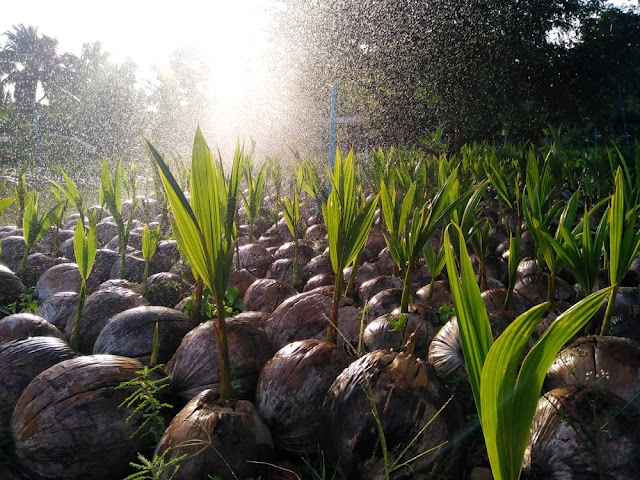Care of Coconut garden

https://makinggardenblog.blogspot.com/2023/05/making-coconut-garden.html
Dwarf Coconut Tree: How to Care, Tips for Planting and Cultivating in your Garden
The dwarf coconut tree is a historic plantation! It was brought from Asia by the Portuguese in 1553. Since then, the dwarf garden coconut has become one of the most amazing species to cultivate.
In Brazil, we have 3 species of dwarf coconut trees for the garden: the green of Brazil, the green of Malaysia and the green of jequi.

https://makinggardenblog.blogspot.com/2023/05/making-coconut-garden.html
But the true triumph of the dwarf coconut garden is its fruit: the coconut. After all, there's nothing better than enjoying the heat accompanied by a cold coconut water, right?
Before learning how to plant a dwarf coconut tree, it is important to learn how to care for it, the best distance to plant a dwarf coconut tree and other important details to ensure a tall, imposing tree full of fruit. Check out everything you need to know about the dwarf coconut tree for the garden and start planting!
Characteristics of the dwarf coconut tree
The dwarf coconut tree is very popular in the coastal regions of Brazil - especially in the northeast. It can reach between 10 and 12 meters in height and blooms on average between 2 and 3 years after planting.
Compared to other trees that produce coconuts, the dwarf coconut palm is considered more sensitive, so it is important to plant it in the most suitable soil and in environments with average temperatures of 27 degrees. If you live in cold places, it's better not to try our tips on how to plant dwarf coconut palms.
The dwarf coconut tree can have 3 types of fruit: the green coconut, the yellow coconut and the red coconut. However, compared to other coconut trees, they are smaller and more rounded.

https://makinggardenblog.blogspot.com/2023/05/making-coconut-garden.html
Tips on how to plant dwarf coconut trees
To learn how to plant your dwarf coconut seedling, consider the following factors:
Temperature : dwarf coconut seedlings develop better at high temperatures (average 27°C);
Soil : the best soil to plant dwarf coconut seedlings is one that has good drainage and a sandy composition, so that the plant absorbs nutrients from the soil.
Another important detail is the distance to plant dwarf coconut trees. You need to leave about 7.50 m of distance to plant dwarf coconut palm in the garden, this way you give enough space for the roots of the plant to strengthen.
It is worth remembering that it is not recommended to use the dwarf coconut tree in a vase. Due to the height, the ideal is to have a garden with a dwarf coconut tree. But if you want to grow the dwarf coconut tree in a pot, buy a 60 liter model to support the weight of the mini tree.
Dwarf coconut tree how to care
To have quality fruit and a tall, beautiful plant in the garden, it is essential to follow our tips on how to care for a dwarf coconut flower. Check out!
Irrigation
The dwarf coconut palm is a water-loving plant! In periods of rain, you don't have to worry about irrigation, but during drought, the ideal is to water the dwarf coconut flower between 20 and 40 liters of water per day.
Although it needs this amount of water, too much water in the soil can damage the dwarf coconut flower's roots. So have a good drainage system.
Homemade fertilizer for dwarf coconut trees
The soil must be fertile and, at least once a year, you can use a homemade fertilizer for dwarf coconut trees that helps the plant flourish.
Ideally, the soil should be rich in potassium, so keep that in mind when planting your dwarf coconut tree.

https://makinggardenblog.blogspot.com/2023/05/making-coconut-garden.html
Advantages of coconut
Now that we know everything about dwarf coconut trees and how to care for them, let's talk about the biggest advantage of having a garden with dwarf coconut trees: the coconut.
By producing about 75 coconuts a year, you will have a good amount at home to use in different ways. Here, we list some options for you to use coconut without selling it.
Consume coconut water;
The pulp is also edible, you can dry it and dissect it to use it in different recipes;
How about some coconut milk? To make it, you just need to process the grated coconut with hot water;
The coconut shell and fiber can be used in handicrafts, such as ropes and rugs. Use your creativity to create beautiful pieces!


Comments
Post a Comment